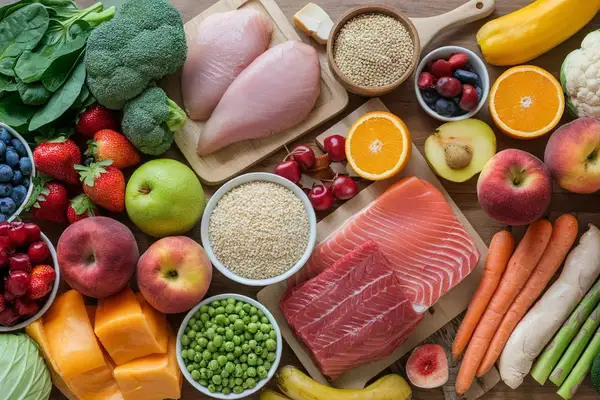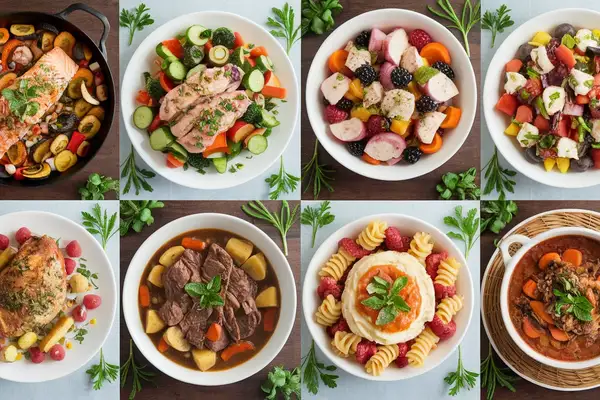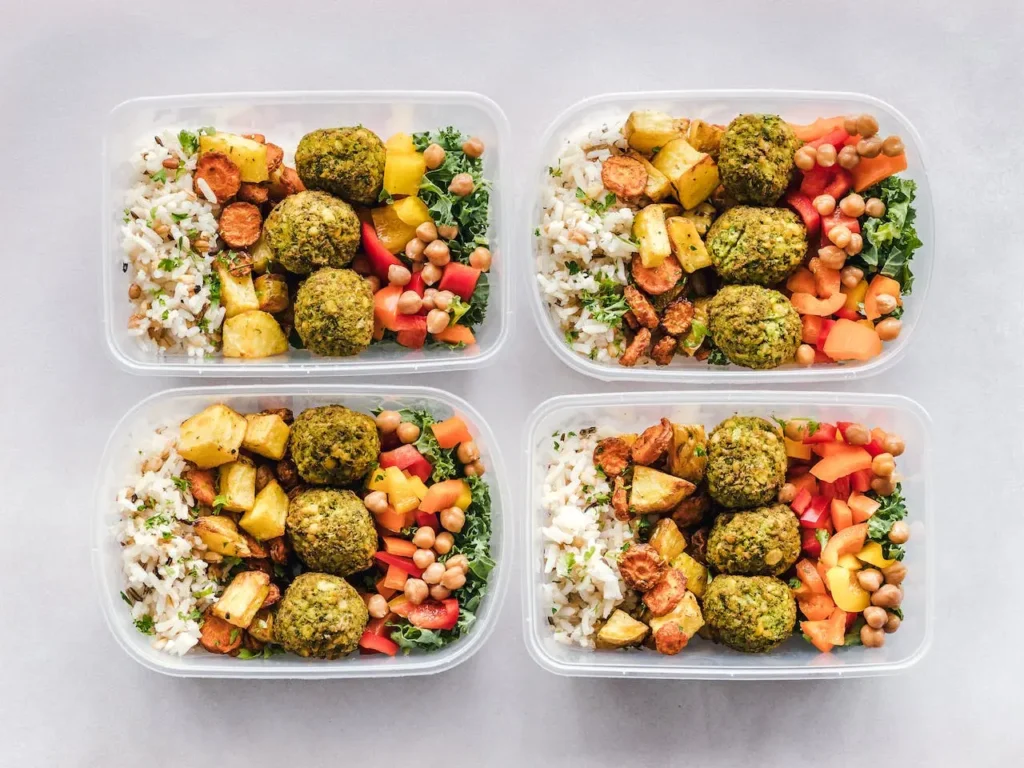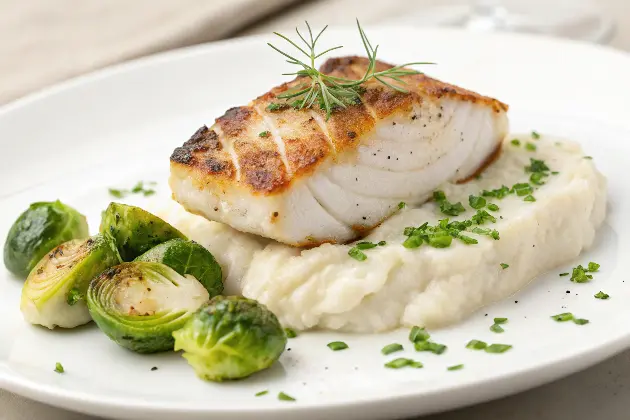Easy 7-Day Protein Diet Plan For Weight Loss
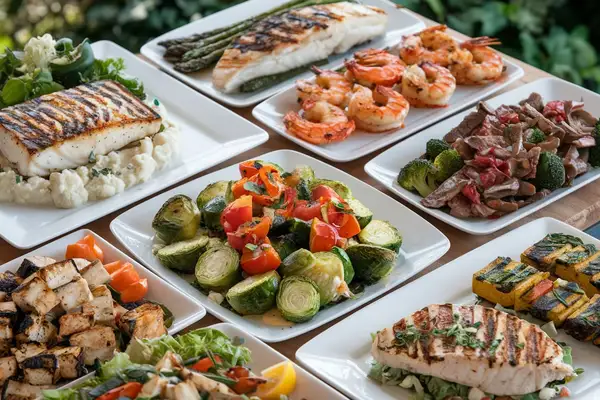
This post may contain affiliate links, meaning I may earn a commission if you make a purchase, at no extra cost to you. I only recommend products I trust. Thank you for your support.
If you’re looking to build muscle, lose weight, or simply feel more satisfied after meals, a high protein diet could be your best bet.
Protein not only helps with muscle repair and growth, but it also keeps you feeling full longer, which can be a game-changer when you’re trying to shed pounds.
This 7-day protein diet plan for weight loss is packed with a variety of delicious high protein foods that are low in calories and most importantly, easy to prepare.
By following this high protein meal plan, you’ll be fueling your body with the nutrients it needs while enjoying tasty, satisfying meals every day.
Why Choose a High Protein Diet?
Protein is an essential nutrient that plays a crucial role in our bodies. It helps build and repair tissues, produces enzymes and hormones, and serves as a building block for bones, muscles, cartilage, skin, and blood.
When you’re trying to lose weight, a high protein diet can help reduce your appetite, increase muscle mass and strength, and boost your metabolism. Plus, it can help you maintain your weight loss in the long term.
High Protein Foods List
These high protein foods contain low calories and can be included in a high protein diet meal plan, which is beneficial for weight loss or maintenance.
Here are some of the low calorie high protein foods:
Fish
- Pollock: Offers 16.5 grams of protein per 3-ounce serving with only 74 calories. It’s also rich in omega-3 fatty acids and various vitamins and minerals.
- Sea Bass: Contains 20.1 grams of protein and 105 calories per 3-ounce serving. It’s low in fat and has a firm, flaky texture.
- Mahi-Mahi: Provides 20 grams of protein with just 92 calories per 3-ounce serving. It’s a versatile fish with a mild, slightly sweet flavor.
- Tilapia: One cooked fillet contains 22.8 grams of protein and 111 calories. It’s an affordable and versatile fish option.
- Cod: Atlantic cod has 19.4 grams of protein per 3-ounce serving with about 70 calories. It’s low in fat and a good source of vitamins and minerals.
- Haddock: Offers 20 grams of protein per 3-ounce serving with approximately 90 calories. It’s mild in flavor and a good source of vitamins and minerals.
Poultry and Lean Meats
- Chicken Breast: Offers 31 grams of protein per 100 grams with about 165 calories. It’s a lean source of protein, ideal for weight loss.
- Turkey Breast: Contains 29 grams of protein per 100 grams and approximately 135 calories. It’s low in fat and a great lean protein food.
- Lean Beef (e.g., sirloin or tenderloin): Provides 31 grams of protein per 100 grams and about 170 calories and can support muscle gain and weight loss if consumed in moderation.
- Pork Tenderloin: Provides 21 grams of protein per 100 grams and about 143 calories. It’s lower in fat compared to other cuts of pork and suitable for weight loss and muscle maintenance.
- Venison: Provides 30 grams of protein per 100 grams and about 158 calories, good for muscle maintenance and gain.
- Bison: Provides 30 grams of protein per 100 grams and about 143 calories. It’s lower in fat compared to beef and ideal for muscle gain and maintenance.
- Rabbit: Provides 33 grams of protein per 100 grams and about 173 calories. It’s very lean and a good source of B vitamins and iron.
- Egg Whites: Offer 11 grams of protein per 100 grams with about 52 calories. They are a low calorie, high protein food with no fat.
Low Fat Dairy
- Greek Yogurt (Non-Fat): Provides 10 grams of protein per 100 grams with around 59 calories. It’s also high in probiotics and calcium.
- Cottage Cheese (Low-Fat): Offers 11 grams of protein per 100 grams and about 98 calories. It’s versatile and can be used in both savory and sweet dishes.
Legumes
- Lentils: Contain 9 grams of protein per 100 grams (cooked) and approximately 116 calories. They’re high in fiber and iron.
- Chickpeas: Provide 9 grams of protein per 100 grams (cooked) and around 164 calories. They’re also rich in fiber and various vitamins.
- Black Beans: Offer 8 grams of protein per 100 grams (cooked) and about 127 calories. They’re high in fiber and antioxidants.
Soy Products
- Tofu (Firm): Contains 8 grams of protein per 100 grams and around 70 calories. It’s a versatile plant-based protein source.
- Tempeh: Provides 19 grams of protein per 100 grams with about 192 calories. It’s a fermented soy product with a nutty flavor and additional probiotics.
Vegetables
- Edamame: Provides 11 grams of protein per 100 grams and about 121 calories. It’s also high in fiber and vitamins.
- Green Peas: Provides 5 grams of protein per 100 grams and about 81 calories. They are also rich in fiber, vitamins A, C, K, and several B vitamins.
- Spinach: Provides 2.9 grams of protein per 100 grams and about 23 calories. It’s also high in iron, calcium, and vitamins A and C.
- Asparagus: Provides 2.2 grams of protein per 100 grams and about 20 calories. It’s rich in folate, vitamins A, C, K, and antioxidants.
- Broccoli: Provides 2.8 grams of protein per 100 grams and about 34 calories. It’s also a great source of vitamins C and K, and fiber.
- Brussels Sprouts: Provides 3.4 grams of protein per 100 grams and about 43 calories. They are also high in fiber, vitamins C and K, and antioxidants.
- Artichokes: Provides 3.3 grams of protein per 100 grams and about 47 calories. It’s also rich in fiber, vitamin C, and antioxidants.
- Kale: Provides 4.3 grams of protein per 100 grams and about 49 calories. It’s also high in vitamins A, K, and C, and has powerful antioxidants.
Seafood
- Shrimp: Offers 24 grams of protein per 100 grams with about 99 calories. It’s low in fat and high in key nutrients like selenium and vitamin B12.
- Scallops: Contain 20 grams of protein per 100 grams and about 90 calories. They’re a good source of minerals like zinc and magnesium.
- Tuna: Offers approximately 25 grams of protein per 100 grams with about 132 calories. It’s low in fat and rich in key nutrients like selenium, vitamin B12, niacin (vitamin B3), and omega-3 fatty acids.
Whole Grains
- Quinoa: Provides 8 grams of protein per 100 grams (cooked) with about 120 calories. It’s also a complete protein source and high in fiber.
- Seitan: Contains 25 grams of protein per 100 grams and about 143 calories. It’s a high-protein meat substitute made from wheat gluten.
- Wild Rice: Offers approximately 4 grams of protein per 100 grams with about 101 calories. It’s a whole grain that is low in fat and provides a good amount of fiber (about 1.8 grams).
7-Day Protein Diet Plan For Weight Loss (High Protein Menu Plan)
This 7-day high protein meal plan features easy low calorie high protein foods and essential nutrients your body needs to support weight loss and muscle maintenance.
This 7-day protein diet plan for weight loss is packed with delicious and nutrient-dense high protein meals, to keep you full, energized, and satisfied throughout the week.
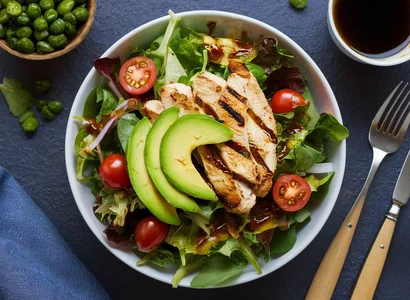
Day 1
Breakfast:
- Greek Yogurt with Berries and Almonds: Mix plain Greek yogurt with fresh berries and top with chopped almonds for a satisfying crunch. (1 cup plain Greek yogurt, 1/2 cup mixed berries, 10 almonds)
Lunch:
- Grilled Chicken Salad: Enjoy a light, refreshing salad with grilled chicken breast, mixed greens, and avocado. Drizzle with olive oil and balsamic vinegar for added flavor. (4 oz grilled chicken breast, mixed greens, 1/2 avocado, cherry tomatoes, cucumbers, olive oil, balsamic vinegar)
Dinner:
- Baked Pollock with Asparagus: Bake pollock fillet and serve with tender asparagus spears, flavored with lemon and herbs. (6 oz pollock, 1 cup roasted asparagus)
Snacks:
- Cottage Cheese with Pineapple: For a sweet and savory snack, pair low-fat cottage cheese with pineapple chunks. (1/2 cup low-fat cottage cheese, 1/4 cup pineapple chunks)
- Protein Bar: A convenient low calorie high protein snack to keep you going. (1 protein bar)
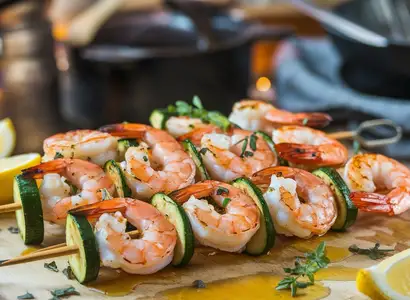
Day 2
Breakfast:
- Egg White Omelet with Spinach and Feta: Start the day with a fluffy egg white omelet filled with spinach and crumbled feta cheese. (4 egg whites, 1 cup spinach, 1 oz feta cheese)
Lunch:
- Turkey and Cheese Roll-Ups: Keep it simple with turkey and cheese roll-ups. Use lettuce leaves as a wrap for a low-carb option. (4 slices turkey breast, 2 slices low-fat cheese, 1 tablespoon mustard, lettuce leaves)
Dinner:
- Grilled Shrimp Skewers with Zucchini: Savor grilled shrimp skewers served with grilled zucchini and a side of brown rice for a light but protein-rich meal. (6 oz grilled shrimp, 1 cup grilled zucchini, 1/2 cup brown rice)
Snacks:
- Protein Shake: A quick and easy protein shake made with protein powder, almond milk, and half a banana. (1 scoop protein powder, 1 cup unsweetened almond milk, 1/2 banana)
- Hard-Boiled Eggs: Simple yet satisfying, enjoy two hard-boiled eggs for a protein boost. (2 hard-boiled eggs)
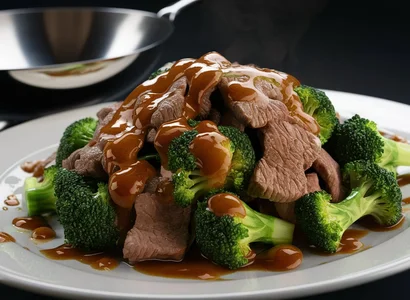
Day 3
Breakfast:
- Overnight Oats with Protein Powder: Prepare the night before by mixing oats with protein powder, almond milk, chia seeds, and diced apples. (1/2 cup oats, 1 scoop protein powder, 1/2 cup unsweetened almond milk, 1 tablespoon chia seeds, 1/2 apple)
Lunch:
- Tuna Salad Lettuce Wraps: A protein-packed lunch with tuna salad wrapped in crisp lettuce leaves for a low-carb meal. (1 can tuna in water, 1 tablespoon Greek yogurt, 1 tablespoon Dijon mustard, chopped celery, chopped onions, large lettuce leaves)
Dinner:
- Beef Stir-Fry with Broccoli: A savory stir-fry made with lean beef strips, fresh broccoli, and bell peppers, seasoned with soy sauce and ginger, and served over cauliflower rice. (150g lean beef strips, broccoli, bell peppers, 1/2 cup cauliflower rice, soy sauce, ginger)
Snacks:
- Greek Yogurt with Almonds: A creamy snack of Greek yogurt topped with a handful of crunchy almonds. (1 cup Greek yogurt, a handful of almonds)
- Peanut Butter and Apple Slices: A sweet and protein packed snack with apple slices spread with creamy peanut butter. (1/2 apple slices)
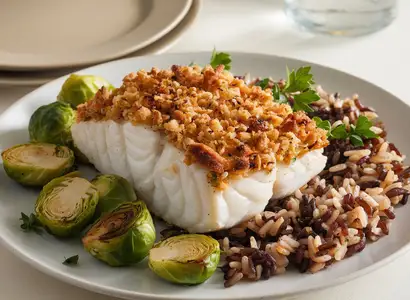
Day 4
Breakfast:
- Protein Pancakes: Whip up a batch of protein pancakes using oats, protein powder, eggs, and almond milk. Top with mixed berries. (1/2 cup oats, 1 scoop protein powder, 1 egg, 1/4 cup unsweetened almond milk, 1/2 teaspoon baking powder, 1/4 cup mixed berries)
Lunch:
- Chicken and Veggie Stir-Fry: A quick stir-fry with chicken breast and mixed vegetables, flavored with a splash of soy sauce. (4 oz chicken breast, mixed vegetables (bell peppers, broccoli, snap peas), 1 tablespoon soy sauce)
Dinner:
- Baked Cod with Brussels Sprouts: Enjoy a lean protein dinner with baked cod served alongside roasted Brussels sprouts and wild rice. (6 oz baked cod, 1 cup roasted Brussels sprouts, 1/2 cup wild rice)
Snacks:
- Low-Fat String Cheese and Carrots: A snack of low-fat string cheese paired with crunchy baby carrots. (1 stick low-fat string cheese, 1 cup baby carrots)
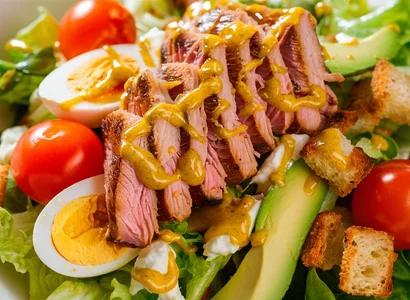
Day 5
Breakfast:
- Chia Seed Pudding with Protein Powder: Prepare this pudding the night before by mixing chia seeds, almond milk, protein powder, and a touch of vanilla. Top with almond butter. (1/4 cup chia seeds, 1 cup unsweetened almond milk, 1 scoop protein powder, 1/2 teaspoon vanilla extract, 1 tablespoon almond butter)
Lunch:
- Grilled Chicken Caesar Salad: A high protein Caesar salad with grilled chicken, romaine lettuce, and a light dressing. (4 oz grilled chicken breast, romaine lettuce, 1 tablespoon grated Parmesan cheese, 1 tablespoon Caesar dressing)
Dinner:
- Tuna Niçoise Salad: A classic and protein-rich salad featuring tuna, hard-boiled eggs, blanched green beans, cherry tomatoes, black olives, and boiled baby potatoes. (200g tuna, 2 hard-boiled eggs, 1/2 cup of green beans, 1/2 cup cherry tomatoes, 1/4 cup of black olives, 1/2 cup of baby potatoes)
Snacks:
- Greek Yogurt with Cucumber Slices: A light snack combining Greek yogurt and sliced cucumbers. (1/2 cup plain Greek yogurt, 1/2 cucumber)

Day 6
Breakfast:
- Scrambled Eggs with Turkey Bacon: A hearty breakfast of scrambled eggs served with turkey bacon and avocado slices. (2 whole eggs, 2 slices turkey bacon, 1/2 avocado)
Lunch:
- Turkey Meatballs with Zucchini Noodles: A lean and flavorful dish featuring turkey meatballs served over zucchini noodles with tomato sauce. (200g ground turkey, 2 zucchinis, 1 cup tomato sauce)
Dinner:
- Grilled Mahi-Mahi with Cauliflower Mash: Enjoy grilled mahi-mahi paired with creamy cauliflower mash and steamed green beans. (6 oz grilled mahi-mahi, 1 cup cauliflower mash, 1/2 cup steamed green beans)
Snacks:
- Pumpkin Seeds and Apple Slices: A snack of crunchy pumpkin seeds and fresh apple slices. (1/4 cup pumpkin seeds, 1 small apple)

Day 7
Breakfast:
- High Protein Smoothie: Blend a protein-packed smoothie with protein powder, spinach, almond milk, banana, and almond butter. (1 scoop protein powder, 1 cup unsweetened almond milk, 1/2 cup spinach, 1/2 banana, 1 tablespoon almond butter)
Lunch:
- Grilled Tofu and Vegetable Skewers: A plant based high protein meal with grilled tofu and colorful vegetable skewers, marinated in soy sauce. (200g tofu, 1 bell pepper, 1 zucchini, 2 tablespoons soy sauce)
Dinner:
- Baked Chicken with Roasted Vegetables: Baked chicken breast served with a medley of roasted vegetables and quinoa. (4 oz baked chicken breast, 1 cup roasted vegetables, 1/2 cup quinoa)
Snacks:
- Almonds and Berries: A simple and nutritious snack of almonds and mixed berries. (1/4 cup almonds, 1/2 cup mixed berries)
- Edamame: A healthy and high protein snack of steamed edamame. (1 cup edamame)
Benefits of a High Protein Diet
A high protein diet offers several benefits, particularly for weight management, muscle maintenance, and overall health. Here are some benefits of a high protein diet:
- Muscle Growth and Repair: Protein is essential for building and repairing muscle tissue. A high protein diet can support muscle growth, especially when combined with resistance training.
- Weight Loss and Management: Protein can help increase satiety and reduce appetite, making it easier to manage portion sizes and reduce overall calorie intake. It also has a higher thermic effect compared to fats and carbohydrates, meaning your body burns more calories digesting protein.
- Preservation of Lean Muscle Mass: During weight loss, a high protein diet helps preserve lean muscle mass, which is crucial for maintaining metabolic rate and strength.
- Improved Metabolism: Protein can boost metabolism due to its higher thermic effect. This can help you burn more calories throughout the day.
- Enhanced Recovery: Adequate protein intake supports faster recovery from exercise by aiding in muscle repair and reducing soreness.
- Better Bone Health: Protein plays a role in maintaining bone health by supporting the structure of bones and helping with calcium absorption.
- Regulation of Blood Sugar Levels: High protein foods can help stabilize blood sugar levels by slowing down the digestion and absorption of carbohydrates, reducing spikes in blood glucose.
- Increased Satiety: High protein diets can help you feel fuller for longer, which can reduce the likelihood of overeating and snacking between meals.
Potential Risks of a High Protein Diet
While a high protein diet can offer various benefits, it may also come with potential risks, especially if followed excessively or without proper balance. Here are some potential risks to consider:
- Kidney Strain: Excessive protein intake can put additional strain on the kidneys, particularly in individuals with pre-existing kidney conditions. The kidneys have to work harder to filter out the byproducts of protein metabolism.
- Dehydration: High protein diets can lead to increased water loss as the body excretes excess nitrogen from protein metabolism. This can potentially increase the risk of dehydration if fluid intake is not adequately maintained.
- Nutrient Imbalance: Focusing too heavily on protein can lead to a lack of other essential nutrients if not balanced with fruits, vegetables, and whole grains.
- Digestive Issues: High protein diets, especially those low in fiber, can cause digestive issues such as constipation or bloating. It’s important to include high fiber foods to mitigate these effects.
- Bone Health: Some studies suggest that excessively high protein intake may lead to increased calcium loss through urine, which could potentially affect bone health over time if not balanced with adequate calcium intake.
- Heart Health: Depending on the source of protein, high protein diets can be high in saturated fats (e.g., red meats), which may impact heart health negatively. Choosing lean protein sources and incorporating plant-based proteins can help mitigate this risk.
High Protein Meal Prep Tips
Meal prepping with a focus on high protein meals can help you stay on track with your dietary goals and ensure you have nutritious options readily available.
Here are some tips for an effective high protein meal prep:
- Plan Ahead: Start by planning your meals for the week. Decide on recipes that incorporate a variety of high protein foods and choose recipes that fit your time constraints and cooking preferences.
- Balanced Meals: Pair high protein foods with vegetables and healthy fats to create balanced and nutritious meals.
- Batch Cooking: Use a slow cooker or instant pot for easy batch cooking of meats and stews. This saves time and ensures you have enough for multiple meals.
- Portion Control: Divide your meals into individual portions using containers. This helps with portion control and makes it easy to grab a meal on the go.
- One-Pan Meals: Opt for recipes that use a single pan or sheet for cooking, like sheet pan chicken and vegetables or a one-pot chili.
- Mix and Match: Prepare versatile protein items that can be used in various dishes, such as grilled chicken that can be added to salads, wraps, or bowls.
- Include Protein in Snacks: Prepare high protein snacks like hard-boiled eggs, protein bars, or cottage cheese for convenient options throughout the day.
- Use Herbs and Spices: Enhance the flavor of high protein meals with herbs, spices, and marinades to keep them enjoyable.
Conclusion
A 7-day high protein meal plan is a fantastic way to boost your protein intake, whether your goal is weight loss, muscle gain, or overall health improvement.
This article provides a thorough 7-day protein diet plan for weight loss, focusing on low calorie high protein foods to support weight loss while ensuring you enjoy a variety of high protein meals.
By incorporating a variety of high protein foods and keeping meals interesting and diverse, you can enjoy the benefits of a high protein diet without the monotony.
Remember to balance your meals with plenty of vegetables and healthy fats to ensure you’re getting all the nutrients you need.
- Best diet to lower triglycerides
- 7-day anti inflammatory meal plan
- 21-day Fix meal plan for beginners
- 7-day clean eating meal plan for family
- Military diet plan 7 days
- The best diet for endomorphs
- Top 10 alkaline foods
- 7-day candida diet for women
- 14-day real food diet
- 7-day Aldi meal plan
- 7-day oatmeal diet plan
- Type 2 diabetes menu
- Easy Mediterranean diet meals
- 7-day MIND diet menu
- Anemia foods to eat and avoid
FAQs
What vegetables are high in protein?
Vegetables like edamame, kale, and Brussels sprouts are relatively high in protein compared to other vegetables. Edamame provides about 11g of protein per 100g, while kale offers about 4.3g.
How to get 150g of protein a day?
To get 150g of protein a day, include high protein foods in every meal and snack. For example, eat eggs for breakfast, chicken breast for lunch, lean beef or fish for dinner, and supplement with protein rich snacks like Greek yogurt, cottage cheese, and protein shakes.
How much protein do I need daily?
The recommended daily protein intake varies, but a general guideline is 0.8g per kilogram of body weight. For those looking to build muscle, 1.2-2.0g per kilogram may be beneficial.
Do oats have protein?
Yes, oats do contain protein. One cup of cooked oats has about 6 grams of protein, making it a good addition to a high protein diet.
Are bananas high in protein?
No, bananas are not high in protein. A medium banana contains about 1.3 grams of protein. They are more known for their carbohydrate content and are a good source of vitamins and fiber.
What drink is high in protein?
A protein shake made with protein powder, such as whey or plant-based protein, is a high protein drink. Additionally, drinks like kefir and certain yogurts can provide a good protein boost.
